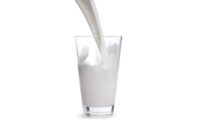Sponsored by:

Milk is a bargain. A gallon of whole milk fell 47 cents to $3.39 in August from a peak of $3.86 in December 2014, according to the Bureau of Labor Statistics. Unit sales in the whole milk category rose 3% and dollar sales rose 1.9% to nearly $4.8 billion for the 52 weeks ended Aug. 9, 2015, according to market researcher IRI. (The Chicago-based research firm found the average price was $3.13 for the period.)
That is good news for fluid milk processors, but it needs to be put into a broader context. The much larger skim milk category saw sales decrease 6.3% to $9.8 billion, with unit sales tumbling 5%. The average price of a gallon of skim milk fell 4 cents to $3.08 a gallon during the period.
So where are the opportunities for milk processors? Dairy executives we spoke with point to flavors, smaller formats and innovations.
Beyond chocolate, strawberry
Flavors can spur milk sales. While chocolate and strawberry are the old standbys, dairies are drawing inspiration from confectionery companies. Consider Prairie Farms and its Peeps-flavored milk. Peeps are those marshmallow candies from candy maker Just Born Inc., Bethlehem, Pa. Prairie Farms, a dairy cooperative based in Carlinville, Ill., introduced Marshmallow Milk, Chocolate Marshmallow Milk, and Easter Egg Nog flavors in March. In a statement, a brand manager envisioned consumers “using the limited-edition beverages in recipes, coffee or as an accompaniment to a favorite cereal.”
Despite some negative reaction in the popular press to the sugary milks, the dairy industry supported the idea. The International Dairy Foods Association bestowed its Ingredient/Flavoring/Seasoning/Additive Innovation Award on the product, based on votes cast at the International Dairy Show in Chicago in September.
Limited-time offers, like the Peeps milk, create excitement in the milk category, dairy executives said.
Flavored milks represented incremental business, said Dean Foods Co. Marketing Director Greg Schwarz. He said these flavored products expand sales in the fluid milk category rather than take sales away from white milk.
Consumers are willing to buy a quart or two of the novelty flavor in addition to their regular purchases of white milk. There’s good money in the strategy. Consider Mint Chocolate Chip milk from Promised Land, Floresville, Texas. The suggested retail price for a quart is $2.99 (the equivalent of nearly $12 a gallon.) Promised Land offer Mint Chocolate Chip from May to August. Its other limited-time flavor offerings this year were Pumpkin Spice and Salted Caramel Latte.
Dallas-based Dean Foods, the largest dairy company in the United States, has found success with its limited-time flavors. Last year it rolled out Orange Scream milk under its TruMoo flavored milk brand. The flavor tastes like the classic orange creamsicle novelty. Earlier in the year, TruMoo came out with a Chocolate Marshmallow flavor. By adding a call to action on the packages to warm the milk in a microwave oven, Dean Foods showed consumers a second way to use the product (besides drinking it cold).
Flavors and formats can be used to attract different demographic targets. While moms tend to purchase gallons or other multiserve sizes in grocery stores, young men are buying chocolate milk in single-serve bottles in convenience store channels where young men tend to shop. This consumer demographic (men ages 18 to 28) are not necessarily athletes looking for a high-protein recovery beverage, Schwarz said. Rather, these buyers simply want a good-tasting chocolate milk, he said.
“The milk industry is seeing positive momentum with flavored milk, including some periods of double-digit growth as 2015 comes to a close,” said Julia Kadison, CEO, Milk Processor Education Program (MilkPEP). She said flavored milk sales are up over 6% volume growth year-to-date, and the growth is primarily driven by retail sales, including packages of all sizes, from single-serve to gallons.
“We’re also starting to see more innovation in this space, with new products such as TruMoo Protein and Fair Life, which are driving excitement, addressing consumer needs and making milk feel more contemporary,” Kadison said.
Ethnic influences
Steuben Foods, a dairy processor and contract manufacturer in Elma, N.Y., developed a flavored milk shake by looking at trends in flavors, demographics and packaging. Steuben Foods is selling a milk-based horchata under its house brand called Elmhurst Naturals. Steuben saw the convergence of interest in Hispanic foods and culture and Millennials desire for single-serve, on-the-go packaging, said Stacey Inglis, Steuben Foods’ director of R&D and marketing. She talked about the product in a Dairy Foods webinar in September. (Listen to her presentation in the webinar archives at dairyfoods.com.)
Horchata is a traditional drink popular with Hispanic consumers, but Inglis expects the drink to find a larger audience. The ready-to-drink product is packaged in a 10-ounce aseptic bottle in three flavors: traditional, cocoa and dulce de leche. The suggested retail price is $1.99 to $2.49. The horchata is sold in participating 7- Eleven nationwide locations and regional grocery retailers.
Steuben Foods is the manufacturer of Cold Stone Creamery Milk Shakers, a product line launched in 2012 with Kahala Brands, parent company of ice cream retailer Cold Stone Creamery. Inglis said this product came about because of several overlapping trends. She said milkshakes are on 5% of restaurant menus, consumers have a desire for “indulgent” foods, sales of flavored milk are rising and aseptic packaging creates a shelf-stable beverage. The milk shakes are made in Chocolate Fudge Brownie, Caramel Coffee Dream, vanilla and strawberry flavors. A new flavor to be released in 2016 is Birthday Cake.
Nonmilk milk
HP Hood, Lynnfield, Mass., created a dairy beverage made with milk called MilkWise. Company spokeswoman Lynne Bohan said Hood held focus groups with milk drinkers and asked them about their relationship with milk. They told Hood they wanted a milk with great taste, lower sugar and fat content, and fewer calories. Though they did not seek protein, they did want more calcium.
The refrigerated beverages are made with water blended with low-fat milk. They are sweetened with real sugar. Two SKUs are vanilla-flavored. An 8-ounce serving has 40 or 70 calories, depending on the product.
MilkWise “addresses families with multiple milks in their refrigerators,” Bohan said, and it can be used in cereals and smoothies. She described the beverage as “light, crisp and refreshing.”
The product is available in New England grocery stores. Though it is sold alongside specialty milks, the product does not meet the standard of identity for milk.
Hot buttons
When they buy groceries, consumers are shopping the perimeter of the store more heavily, said Christine Bellamo, the director of dairy for Daymon Worldwide. Part of the reason is high interest in less processed foods and a desire to buy foods with clean ingredient decks. Prepared packaged and canned foods in the center of the store are losing out, she said.
Consumer interest in clean labels and pure foods behind the five-point “purity promise” of DairyPure, a national milk brand created by Dean Foods. Among the promise is not to use milk with artificial growth hormones, to test all milk for antibiotics and to continually quality-test milk to ensure purity.
Selling the story of milk
A national marketer has more resources to support the brand than does a local dairy. While there are national brands of organic milk (notably Horizon and Organic Valley), there isn’t a national brand of conventional milk. Dean Foods is trying to make DairyPure a national brand. The DairyPure logo appears with those of Dean’s regional brands (like Garelick Farms, Mayfield, T.G. Lee and Alta Dena).
The Milk Processor Education Program (MilkPEP) supports the dairy industry by promoting milk at the national level. Local dairies pay into MilkPEP and have access to its marketing materials. As sales of plant-based beverages have taken off, MilkPEP has become more aggressive about promoting milk’s inherent nutrition and benefits.
Kadison said that nearly 60% of Americans consider protein when purchasing packaged foods and beverages, and most are trying to get more in their diet. Still, many consumers are unaware of milk’s protein, she said.
“Simply sharing the ‘new’ news of milk’s protein could have huge potential to positively impact milk consumption, according to recent proprietary consumer research from MilkPEP,” she said.
A new initiative to be launched in 2016 is titled “My Morning Protein.” MilkPEP will show consumers how milk can be part of a protein-rich breakfast.
“We found that when we communicate milk’s protein benefits as a morning ‘pair’ and part of a meal solution, such as having an egg sandwich with a glass of milk, we can drive demand for milk. With a versatile product that naturally delivers high-quality protein, it’s as easy as just adding milk to get to the protein you need in the morning to start your day with energy and focus,” she said.
What are the opportunities?
Dairy processors have to work hard to sell milk and they’ll have to work harder to sell more milk. Dairies need to sell eight pints to equal one gallon. That’s a heavy burden. But as noted, gallon sales of skim milk (the most popular variety) are declining.
A gallon jug is just too large for Baby Boomer and Millennial households, said Bellamo, of dairy Daymon Worldwide. They want smaller formats and variety in their refrigerators.
The opportunities for fluid milk processors include:
- Smaller formats
- Flavors
- Value-added
- Functional milks
- Aseptic
Smaller formats and flavors go together. A limited-time offer creates urgency. Dairy processors learned that a long time ago from sales of egg nog. So they are creating new themed milks around holidays and occasions. Prairie Farms released its Peeps flavor in the spring.
High-protein milks and milk shakes fill a need. As nutrition experts stress the importance of protein, consumers are getting the message. A glass of milk with meals or as a snack helps consumers meet daily protein requirements. Nutrition research is finding benefits to consuming milk fat. Processors might consider increasing production of whole milk beverages.
Aseptic packaging puts milk into the center of the store where it can be merchandised with other beverages. Stores will re-set dairy products by dayparts, such as breakfast, snacking and dessert, said Bellamo. Thus, consumers might buy refrigerated milk for their breakfast cereal and a shelf-stable chocolate milk as a snack for later in the day.
Milk prices won’t stay forever at $3.13 a gallon. But what remains true is that milk is a great canvas for flavors and a good delivery system for nutrients. That’s something to drink to.
Milk | Cheese | Cultured | Ice Cream | Butter | Non-dairy Beverages | Ingredients | Exports












